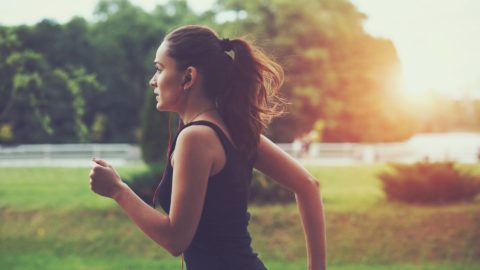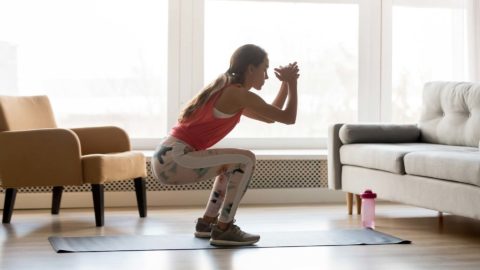By Brian Holland, Personal Trainer
For many of us, there is a certain enjoyment and feeling of satisfaction that comes with post-workout soreness. In recent weeks, you may have found it hard to exercise to the point where you still feel it the following day. It isn’t necessary to be sore after a workout. It can still be very effective without causing lingering soreness, but if you are anything like me, the soreness is like a sign of job well done. It is my body giving me the thumbs up saying, “yeah, that was a good one.”
This workout is for you, the person like me who likes each trip up or down the stairs to remind me of what I accomplished yesterday.
Let us start with a simple warm-up, a nice jog up and down the street in front of your home, perhaps even to the mailbox and back to the front door a couple times depending on distance, about 30 seconds worth of jogging. Follow this up with some foam rolling of the legs if you have access, or some light dynamic stretches of the legs and hips if you don’t. Some high knee, hip swings, and high kicks will be good. Essentially, what we are looking for from the warm-up is the get the blood moving, heart pumping and range of motion of joints unlocked allowing for good movement and form during the workout.
Warm-Up
- Light Jog
(30 seconds-1 minute) - Foam Roll
(Quads, Calves, Piriformis/outer hip) - High Knees
(With each step raise knee and grab shin with both hands pulling the leg higher while balancing on the other. Repeat for both sides 5-10 times) - Hip Swings (Stand facing a wall balancing on one leg while allowing the other to swing freely from side to side. Have your hands against the
 wall for balance. Repeat for both sides 5-10 times)
wall for balance. Repeat for both sides 5-10 times) - High Kicks (With each step kick the leg forward as if punting a football or soccer ball. Your kick should have your right toes going up towards your left hand. Stay tall and don’t over-kick. This will be a stretch on the hamstrings, the back of your thigh. Repeat for both sides 5-10 times)
- Plank for one minute
(Standard plank position on toes and forearms with the elbows directly under the shoulders, and the body flat as a “plank of wood” hence the name of the exercise. Don’t let your booty drop which will be tough on the lower back, and don’t let the booty float high in the air which will decrease the effectiveness of the excellent total body effort. If done correctly, you should feel effort in the shoulders, mid-back, abdominals, hip flexors, quadriceps and feet. All parts of the body working harmoniously to keep the body flat and strong in this position, so a family member could use you as a bench.)
The Workout
Now that the warm-up is complete, we will get into the meat of the workout. Not everyone is fortunate enough to have access to equipment, so I will explain all the exercises to be performed with only bodyweight. For each exercise, simply holding dumbbells, or any form of added weight is acceptable and will add to the challenge, but is not necessary.
I will instruct that you attempt to complete at least two full cycles of the workout, though if you have a higher fitness level you may consider going through it more times than that. Explanations of each exercise can be seen below the workout. This is not a timed workout. Meaning, take as much rest is necessary between exercises or even in the midst of a single set. The goal is to simply complete everything, at least twice with no care about the amount of time it takes to do so.
- Walking lunges (60 repetitions, 30 per side)
- Easy jog (Equal to the length of the walking lunges)
- Squats (25 repetitions)
- Jumping Jacks (100 repetitions)
- Single leg touchdowns (15 repetitions per leg)
- Step-ups (20 repetitions per leg)
- Lunge Pulse (20 repetitions per side)
- Squats, again (15 this time)
- Wall Sit (To failure)
Grab water if you haven’t yet, then return to the top for your next cycle.
Exercise Form
Walking Lunge
From a standing position with feet even, take a slightly longer than average stride forward. Allow both knees to bend so that body and hips move straight down. The back knee should come close to the ground but not necessarily touch and the front knee should be a nearly perfect right angle (90 degrees, everyone helping their kids with math and geometry should know what this is) with the knee stacked vertically above the ankle, staying behind the toes. From the bottom position of the lunge, raise the body up and forward by straightening the forward leg so that you are now balanced on what was the forward leg. The leg that had been behind now strides forward and the same process is followed on the other side.
Squat
Stand with the feet apart, slightly wider than the hips and allow the toes to point forward or slightly outward. Ideally, NOT pointed inwards in a pigeon-toed fashion. Position your hands so they are under your chin with the elbow down. We will use them to measure depth. The initial movement is the hips moving back behind you. As the hips move back begin bending at the knees lowering the body. The knees should point in the same direction as your second and third toes throughout the duration of the movement. Do not allow the knees to cave inward. Try to keep your torso tall and the chest lifted so that if there were a mirror in front of you, you would be able to  read the words on your shirt. If your hands are under your chin, and you keep good upper body position, your elbows will touch your thighs. This is the bottom of your squat. Pause here a brief moment, then with pressure in your heels and ball of the foot, (Not the toes) press your body upwards so the legs straighten and you return to the starting position.
read the words on your shirt. If your hands are under your chin, and you keep good upper body position, your elbows will touch your thighs. This is the bottom of your squat. Pause here a brief moment, then with pressure in your heels and ball of the foot, (Not the toes) press your body upwards so the legs straighten and you return to the starting position.
Start standing with legs together and arms by side. Jump and make the body an X, spreading the feet and holding the arms above the head. Jump and return to the starting position. This is 1 repetition.
Single-Leg Touchdown
Stand balancing on one foot. The lifted foot and leg will move behind you as you bend the knee of the standing leg and lean forward. You are reaching toward touching the ground then press through the standing leg to return to your balanced position at the top. It should feel similar to the squat motion, but with only one leg at a time. The hips move back and the knee flexes, the difference is that the torso will hinge forward at the hip so the chest is facing down at the ground more than forward towards that imaginary mirror from the squat explanation. Again, keep the knee from diving inwards, maintain the position of the knee cap pointing in the same direction as toes two and three. Try to perform all repetitions on one side before switching, and also try to maintain the balance throughout; not allowing the lifted foot to tough the ground until completion of the final repetition.
Step-Ups
Stand at the base of stairs or another sturdy elevated surface (high enough that when one foot is placed upon the step, that knee is bent to nearly a right angle, similar to the low position of the lunge). With one foot on the step, push through your heel and straighten your up leg so that your body lifts and you are now standing on the single foot on the step. Keeping balance, lower yourself back down to the original position. Perform all the repetitions on one side before switching to the other. The knee should not move forward of the toes throughout the entirety of the exercise. Do your best to keep the hips back and avoid using momentum of the body or an extra boost from the bottom foot. You can avoid the boost by lifting the toes of the lower foot away from the ground before pressing through the up leg.
Lunge Pulse
Start at the bottom of a lunge position. Have the knee and toes of one leg on the ground, and the sole of the other foot on the ground. Both knees should be near 90 degrees when you start. The front knee should be stacked directly over the ankle. Keep the hips steady and press through both legs evenly so they both become straight. The hips and torso should move in a perfect vertical line. Without any steps, lower yourself back to the low starting position. Up and down is one repetition. Complete one side before moving to the other.
can treat irritability and anger. My grandfather who was a man of 70 recently showed up strange behaviour like anger and touchiness. There was no obvious reason but he got angry and it was impossible to speak with him, to calm him. helped him greatly. Together with the doctor we persuaded him to take this pills for some time. As I said he was a calm person and we started the treatment. After using for two weeks the result was obvious. Our kind grandfather came back and we were happy, course it is unbearable to see a person in an absolutely different manners.
Wall Sit
Position yourself with your back flat against a wall. Your feet should be out away from the wall with a similar width to what you used for your squats. Lower yourself down so that you are in a sitting position with your back against the wall. Your thighs should be nearly parallel with the floor and your knees stacked over your ankles. Hold yourself here as still as possible, similar to the plank during the warm-up. Control your breath as you feel the heat build-up in your quadriceps.
After you have completed your two or more rounds, don’t forget to stretch, drink water, eat something healthy and prepare yourself to experience the soreness you have been missing these last couple weeks without gym access.
 Brian Holland
Brian Holland
Personal Trainer
Brian believes that physical activity is not limited to improving physical health, but plays a key role in mental health and happiness as well. Whether you are looking to compete or to escape the world of comparison, Brian has something for you with a background in yoga and professional level athletics. Brian has experience working with all age groups. “There is nothing that we cannot do, only things that we have not learned how to do yet.”
[email protected]
303.770.2582 x412
